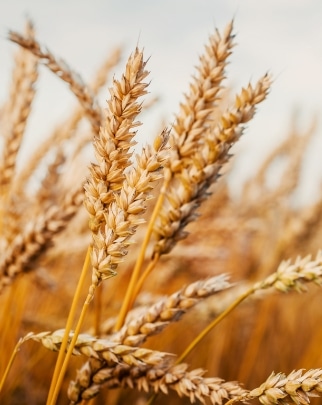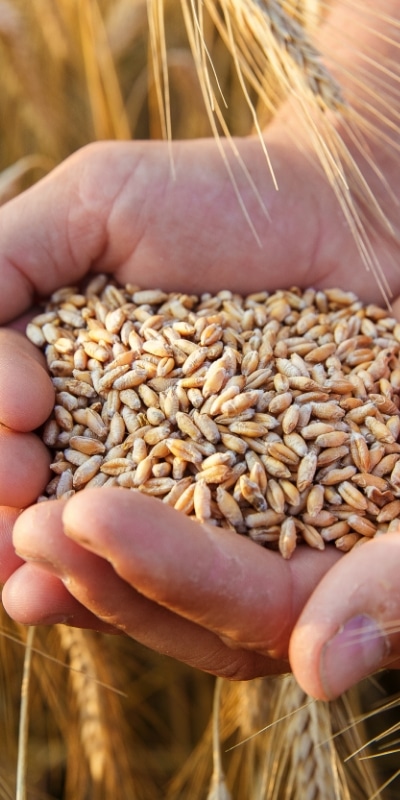
Health
benefits
Wheat is rich in carbohydrates, an essential nutrient in a healthy, varied diet. In fact, carbohydrates should represent 40-55% of our daily energy intake (Anses, PNNS). Starchy foods, including wheat wheat, are therefore basic food products.
Did you know that wheat is also an important source of protein? 100% plant-based, of course. Yet we don’t usually think of it when we’re talking about the food transition that is so important to the health of mankind and of the planet. We need to put more plant-based foods on our plates, and wheat can be one of them.
As well as carbohydrates and proteins, wheat also contains fibre and minerals:
- Rich in phosphorus. Phosphorus contributes to strong bones and healthy teeth, as well as energy metabolism.
- A source of potassium. Potassium helps to maintain our immune system and muscle function, as well as normal blood pressure.
- A source of magnesium. Magnesium helps, among others, to reduce fatigue, keep our muscles working properly and maintain normal bone structure.
Nutritional
values

The right time
to eat it
The wheat harvest takes place from June to October.
- January
- February
- March
- April
- May
- June
- July
- August
- September
- October
- November
- December
Vegetable garden
or city balcony
Wheat is a cereal that belongs to the grass family. The plant has a rigid stem ending in a spike, with leaves rolled in a whorl. It grows to between 60cm and 1.2m and is a winter crop. After fertilisation, the flowers remain closed, eventually producing the wheat grain. Wheat grains vary in size, shape and colour, depending on the variety. They can be white, red, yellow… The wheat grain is made up of three main components: the germ, the kernel and the husk.
Durum wheat is used to make pasta, while soft wheat is used to make bread. Wheat is one of the first plants ever cultivated by mankind. The wheat cycle lasts around 9-10 months in all, from sowing in the autumn until harvesting in July. Wheat is harvested when the plant turns yellow and dries out. To separate the grain from the chaff, the wheat must be threshed. The stems are used as straw when dry, while the grains are processed into flour or semolina.
Choosing
and storing
Like all cereals, wheat needs to be stored in a cool, dark place. Storage methods vary according to the type of warehouse. If storage is temporary and for a limited time, grain can be kept in sacks in a cool place.
Once used in food products, shelf life varies depending on the product. Dry pasta, for example, keeps for longer than fresh pasta or bread.
Tips
and tricks
Wheat has a very wide range of uses and is the basic ingredient in many foods that we eat every day. Bread and pasta are just a couple of examples.
On the one hand, common wheat is transformed into flour. It then forms the main ingredient of foods such as bread, biscuits and pastries – foods that we find ready to eat in the shops. We can also use flour for a wide range of creative recipes in the kitchen at home, savoury or sweet, such as pancakes, shortcrust pastry, cakes…
What is the environmental
impact of wheat?
We can find out more from its PEF (Product Environmental Footprint) score! This is a score established by Agribalyse*. It takes into account every stage in a vegetable’s life cycle: how it’s cultivated, what’s the impact of processing and transport, etc. The lower the score, the less impact it has on the environment.
- Whole durum wheat, raw: 0.14
- Raw beef steak: 2.77
*Figures drawn from the Agribalyse database, which calculates the environmental score of different types of food. This unique score is a weighted average of 16 indicators, calculated according to the European PEF methodology. It does not correspond to an environmental label or ‘eco-score’.
CO2 equivalent: for 100g of whole durum wheat, 0.115kg of CO2 eq, or as much as from 3.4g of raw beef steak.

Can everyone eat it?
Wheat can gradually be incorporated into a child’s diet from the moment they start eating a wider variety of foods. It is recommended to introduce foods containing gluten before the age of 12 months. This can be done through pasta or bread, which contain wheat. Young children often love the taste and texture of bread.
It’s hard not to like wheat, given its many uses in our diet. Everyone will find something to their liking and/or a recipe that uses wheat or wheat-based foods that they enjoy.
Where does it come from?
The origins and varieties of wheat
Wheat originated in the Middle East, where it became a key crop for small villages more than 7000 years ago. Since then, it has migrated to Europe. The generic label of “wheat” actually covers around 20 varieties and sub-varieties, the most common of which are durum wheat and common wheat.
- Durum wheat
- Common wheat
- Einkorn wheat
- Emmer wheat
- Spelt
- …



 Vegetable garden: growing Chinese artichoke
Vegetable garden: growing Chinese artichoke 










